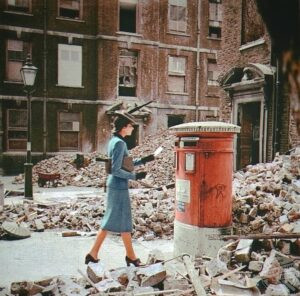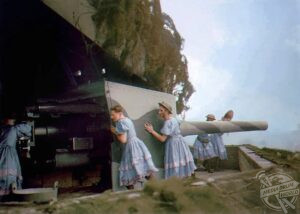By Freya Coombes
THESE COLOURISED images show the quirky side of WWII including cross-dressing soldiers, weddings in bombed buildings and book shopping in a ruined store.
One image shows two members of the National Air Red Precautions Animal Committee (NARPAC) carrying a dog in an ‘Animal Ambulance’. The NARPAC was created at the start of WWII, advising owners to send their pets to the country or put them down.

Another image shows a woman emerging from a bombed house in a wedding dress. This was international dancer Miss Ena Squire-Brown, leaving to marry officer J. C. Martin on November 5th 1940 despite the recent bombing of her home.
These images were colourised by professional colouriser Angelina Karpunina (36) from Saint Petersburg, Russia.

“I am grateful to them for their trust, and I try to meet their expectations and do a very good job. Any detail in the photo has a meaning for them.
“I’ve been colourizing photos for almost 10 years now. I have always been interested in the unusual side of history, unusual pictures, strange inventions.”
Another photo shows British soldiers manning anti-aircraft guns in women’s clothes. Taken in 1940 at Shornemead Fort in Kent, the troops were rehearsing in drag for their Christmas charity performance, keeping themselves entertained in dresses.
One image shows readers continuing to browse the bombed Holland House Library. Built in 1605, the library was bombed during the built in 1940, but that didn’t stop literary enthusiasts.

“My goal for my work is to help others with the study of history. By bringing old photos to life in colour, I hope to help make history more relatable, interesting and sometimes fun,” said Angelina.
“To me, I like how they can inspire and show us that a person has always created and invented, even in difficult times.
“After all, colour brings us closer to history. Colour photos erase the timeline.”
ENDS










